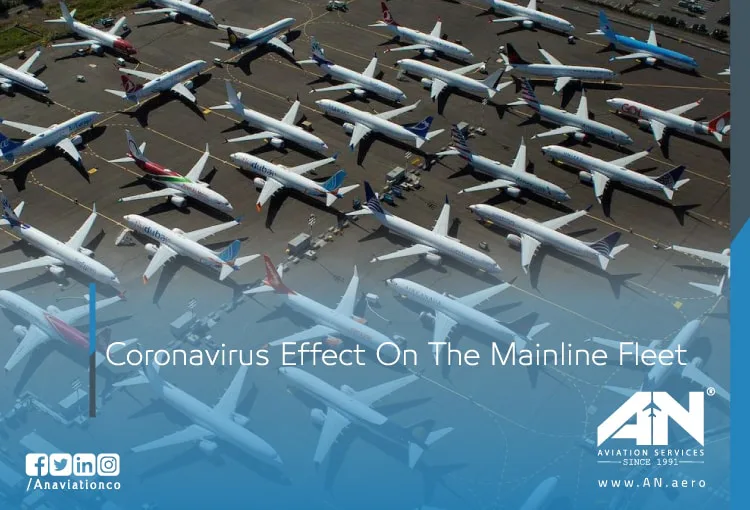
The aviation industry faced one of its most challenging periods in history when the Coronavirus (COVID-19) pandemic swept across the globe. For mainline fleets, the pandemic was a moment of reckoning, as airlines had to ground aircraft, reassess operations, and reconfigure their fleets to meet reduced demand and changing passenger expectations.
In this post, we explore how the pandemic affected the mainline fleet, the long-term implications for the aviation sector, and the strategies airlines are adopting to adapt to the post-pandemic world.
Understanding the Mainline Fleet
A mainline fleet refers to the aircraft operated by an airline for its primary domestic and international routes. These fleets often consist of medium- to large-sized aircraft such as the Airbus A320 family or Boeing 737s, and they are the backbone of airline operations.
When the pandemic hit, global travel restrictions and plummeting passenger demand forced airlines to make tough decisions about their mainline fleets. Many aircraft were grounded, retired, or stored, leaving runways and maintenance facilities filled with idle planes.
Immediate Effects of COVID-19 on the Mainline Fleet
The pandemic disrupted mainline fleet operations in ways that were previously unimaginable. Here’s how airlines were directly impacted:
1. Massive Groundings:
With travel bans and lockdowns in place, airlines were forced to ground the majority of their mainline fleets. Passenger volumes dropped to record lows, making it financially unsustainable for airlines to operate many of their scheduled routes.
2. Fleet Simplification and Retirements:
To cut costs, airlines accelerated the retirement of older, less fuel-efficient aircraft such as the Boeing 757, 767, and certain A320 models. The goal was to simplify fleet operations, reduce maintenance expenses, and transition to more efficient aircraft for future use.
3. Shift to Cargo Operations:
With passenger demand in decline, airlines turned to cargo services as a lifeline. Several mainline aircraft were temporarily converted into freighters, transporting essential goods like medical supplies, vaccines, and e-commerce items.
4. Deferred Aircraft Orders:
Many airlines delayed or canceled orders for new planes as part of cost-cutting measures. This created ripples across the aviation manufacturing sector, impacting companies like Airbus and Boeing.
Long-Term Implications for Mainline Fleets
The effects of COVID-19 on the mainline fleet will be felt for years to come. Here’s a closer look at the lasting changes in fleet management and operations:
1. Focus on Fuel Efficiency:
Airlines are prioritizing fuel-efficient models like the Airbus A321neo and Boeing 737 MAX to reduce operating costs and meet environmental goals. These aircraft are not only economical but also better suited for the changing demands of air travel.
2. Flexible Fleet Planning:
The pandemic underscored the importance of flexibility in fleet planning. Airlines are now diversifying their fleets with aircraft capable of serving multiple roles, from high-demand routes to low-density markets.
3. Rise of Smaller Aircraft:
With reduced passenger volumes, smaller aircraft have become a preferred option for many airlines. Narrow-body planes like the A320 and 737 families are being deployed on routes that once relied on larger, wide-body jets.
4. Resilient Maintenance and Storage Strategies:
The extended grounding of mainline fleets revealed the need for robust maintenance and storage protocols. Airlines are now investing in technologies to keep grounded aircraft in optimal condition for quick redeployment.
The Recovery of the Mainline Fleet
The recovery of mainline fleets has been uneven across the globe, depending on the pace of vaccination campaigns, border reopening, and passenger confidence.
1. Domestic vs. International Travel:
Domestic travel rebounded faster than international travel, as travelers opted for short-haul flights within their countries. Mainline aircraft were redeployed to these routes, while long-haul fleets remain underutilized in many regions.
2. Increased Demand for Leisure Travel:
As restrictions eased, leisure travel surged, prompting airlines to reconfigure their mainline fleets to cater to popular vacation destinations. This shift has influenced route planning and fleet utilization.
3. Hybrid Passenger-Cargo Models:
The cargo boom continues to drive revenue for airlines, and many carriers have adopted hybrid models, where passenger aircraft are also used for cargo transport. This trend may become a permanent feature of the mainline fleet strategy.
Strategies for a Resilient Future
The pandemic has forever changed the way airlines approach fleet management. To ensure resilience, airlines are implementing several forward-looking strategies:
Investment in Sustainable Aviation:
Airlines are adopting sustainable aviation fuels (SAF) and advanced aircraft designs to reduce carbon emissions. This aligns with global goals for greener air travel and enhances the long-term sustainability of mainline fleets.
Technological Upgrades:
Digital solutions, such as predictive maintenance and real-time monitoring, are helping airlines optimize mainline fleet performance and reduce operational disruptions.
Enhanced Passenger Experience:
With competition heating up post-pandemic, airlines are upgrading their mainline fleets with modern interiors, better in-flight entertainment, and health-conscious features to attract passengers.
Conclusion
The mainline fleet has faced unprecedented challenges during the COVID-19 pandemic, but it has also emerged as a focal point for innovation and resilience in the aviation industry. From adapting to cargo operations to accelerating fleet modernization, airlines are reshaping their fleets to meet the demands of a rapidly changing world.
As travel resumes and the industry recovers, the lessons learned during the pandemic will shape the future of fleet management. Airlines must continue to embrace flexibility, sustainability, and technology to ensure their mainline fleets are ready for whatever comes next.

